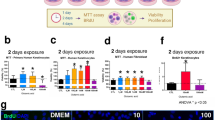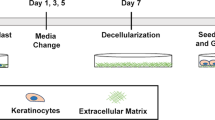Abstract
WE demonstrated previously that the epidermal cells of chick embryos are induced to differentiate by glucocorticoids1,2. Hydrocortisone (0.01 µg ml−1) added to a serum-free chemically-defined medium produced an intense keratinised layer over the uppermost cells3 and many tonofilaments within the basal and intermediate cells4 of the epidermis after 4 d in culture of 13-d-old embryonic chick tarsometatarsal skin. Within 12–16 h of hydrocortisone addition it is possible to show the synthesis of a urea–mercaptoethanol soluble, glycine-rich and metabolically stable epidermal structural protein5 and the accumulation of a urea–mercaptoethanol insoluble epidermal protein(s)4. These changes of protein metabolism induced by hydrocortisone paralleled those seen during in ovo keratinisation of the epidermis4,5. The amino acid composition of the two proteins was very similar suggesting that the soluble protein is converted to the insoluble one in the process of epidermal keratinisation of chick embryonic skin. We show here that the levels of transglutaminase (TG), an enzyme that possibly mediates cross-linking of keratinous polypeptide chains by a ɛ-(γ-glutamyl) lysine bond6–8, increases both during in ovo development of the epidermis and during hydrocortisone-induced in vitro keratinisation of chick embryonic cultured skin.
This is a preview of subscription content, access via your institution
Access options
Subscribe to this journal
Receive 51 print issues and online access
$199.00 per year
only $3.90 per issue
Buy this article
- Purchase on Springer Link
- Instant access to full article PDF
Prices may be subject to local taxes which are calculated during checkout
Similar content being viewed by others
References
Endo, H. et al. in Biochemistry of Cutaneous Epidermal Differentiation (eds Seiji, M. & Bernstein, A.) 359–378 (University of Tokyo Press, Tokyo, 1977).
Sengel, P. in Morphogenesis of Skin 133–136 (Cambridge University Press, Cambridge, 1976).
Sugimoto, M. & Endo, H. J. Embryol. exp. Morph. 25, 365–376 (1971).
Sugimoto, M., Tajima, K., Kojima, A. & Endo, H. Devl Biol. 39, 259–307 (1974).
Kojima, A., Sugimoto, M. & Endo, H. Devl Biol. 48, 173–183 (1976).
Ogawa, H. & Goldsmith, L. A. J. biol. Chem. 251, 7281–7288 (1976).
Buxman, M. M. & Wuepper, K. D. J. invest. Dermatol. 65, 107–112 (1975).
Abernethy, J. L., Hill, R. L. & Goldsmith, L.A. J. biol. Chem. 252, 1837–1839 (1977).
Moscona, A. A., Moscona, M. H. & Saenz, N. Proc. natn. Acad. Sci. U.S.A. 61, 160–167 (1968).
Steinberg, R. A., Levinson, B. B. & Tomkins, G. M. Proc. natn. Acad. Sci. U.S.A. 72, 2007–2011 (1975).
Schutz, G., Killewich, L., Chen, G. & Feigelson, P. Proc. natn. Acad. Sci. U.S.A. 72, 1017–1020 (1975).
Sugimoto, M., Kojima, A. & Endo, H. Devl Growth Different. 18, 319–327 (1976).
Goldsmith, L. A. & Martin, C. M. J. invest. Dermatol. 64, 316–321 (1975).
Lowry, O. H., Rosebrough, N. J., Farr, A. L. & Randall, R. J. J. biol. Chem. 193, 265–275 (1951).
Author information
Authors and Affiliations
Rights and permissions
About this article
Cite this article
OBINATA, A., ENDO, H. Induction of epidermal transglutaminase by hydrocortisone in chick embryonic skin. Nature 270, 440–441 (1977). https://doi.org/10.1038/270440a0
Received:
Accepted:
Issue Date:
DOI: https://doi.org/10.1038/270440a0
This article is cited by
-
Isopeptide bond formation in epidermis
Molecular and Cellular Biochemistry (1984)
-
Localization of transglutaminase in adult chicken epidermis
Archives of Dermatological Research (1978)
Comments
By submitting a comment you agree to abide by our Terms and Community Guidelines. If you find something abusive or that does not comply with our terms or guidelines please flag it as inappropriate.



